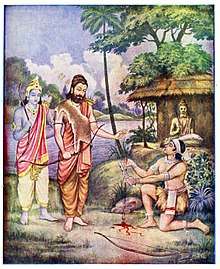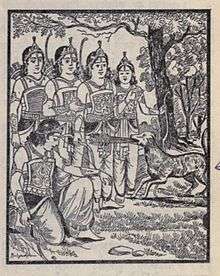Ekalavya
Ekalavya (English: एकलव्य, ékalavya) is a character from the epic The Mahābhārata. He was a young prince of the Nishadha, a confederation of jungle tribes (Adivasi) in Ancient India.
| Ekalavya | |
|---|---|
| Mahabharata character | |
 Eklavya's dakshina of his right hand thumb to his guru | |
| In-universe information | |
| Family | Devashrava (biological father), Hiranyadhanus (adoptive father) Ketuman (son) and another son |
Eklavya is called as one of the foremost of kings in the Rajasuya Yagya where he honours Yudhishthira by offering shoes with respect.[1][2] Though he didn't have his right thumb, he was noted as a very powerful archer and warrior.[3] He was killed by Shri Krishna when he tried to attack Dwaraka and the Yadavas.
Early life
Self-training

In the Mahabharata, Ekalavya was the son of Hiranyadhanus, who was the chief of Bheel tribe , known to be forest dwelling hunters . He served under King Jarasandha's army as General. Ekalavya was hurt when he was rejected by Dronacharya because of an old tradition where the brahmin guru was not allowed to teach shudras or adivasi. Ekalavya still didn't give up on his resolute will to master archery. He once stayed hidden in the forest while guru Drona was teaching the Kaurava and Pandava brothers, after they left for the ashram, Ekalavya collected the mud on which his Guru walked, as a symbolic gesture of want to follow his knowledge and foot steps, later he went into the forest and made a statue of Drona under a big old well grown tree. He began a disciplined program of self-study over many years. He accepted the statue as his guru and practiced in front of it every single day.
Guru Dakshina
One day when Drona and his students were going out into the forest, Arjuna saw a dog that was unable to bark due to an amazing construction of arrows in and all around his mouth. This construction was harmless to the dog, but prevented the dog from barking. Drona was amazed, but also distressed:as he had promised Arjuna that he would make him the greatest archer in the world. Drona and his students investigated, and came upon Ekalavya. Upon seeing Drona, Ekalavya came and bowed to him.
Drona asked Ekalavya where he had learnt archery. Ekalavya replied "under you, Guruji", and showed Drona his statue while explaining what he had done.
Drona then reminded Ekalavya that to truly be Drona's pupil, Ekalavya would have to pay guru dakshina. Readily, Ekalavya offers to do anything for Drona. Drona knew Ekalavya in future will work for Magadha which was enemy of Hastinapur. Drona asks Ekalavya to cut off his right thumb as Guru Dakshina. Happy and Smiling, Ekalavya cuts off the thumb and presents it as Gurudakshina to Dronacharya..
Later life
Eklavya had later become the king of the Nishadas. He was killed by Krishna when he tried to attack Dwarka.The elder son of Ekalvya, Ketuman, succeeded him and later fought from the side of the Kauravas in the Kurukshetra War, and was killed by Bheema.[4] The Nishadas led by Eklavya's son, were posed against Arjuna during Yudhishthira's Ashwamedha Yagna, in which Arjuna defeated and collected tribute from the Nishadas after a furious battle.
Indonesian legend
In Indonesian legend, in a former life Ekalavaya was king Phalgunadi, killed by Drona and reborn as Dhrishtadyumna to avenge the killing.
Legacy
There is an Eklavya temple (Hindi: एकलव्य मंदिर) temple in honor of Mahabharata fame Eklavya in Khandsa village in Sector 37 of Gurugram city in Haryana state of India. As per folklore, this is the only temple of Eklavya and it is the place where Eklavya cut his thumb and offered to guru Drona.[5]
In honor of Eklavya, Government of India runs an Ekalavya Model Residential School (EMRS) model residential school scheme for Indian tribals. Ekalavya Award is awarded by Government of Karnataka for the outstanding performance in sports.
In popular culture
The 2007 movie Eklavya: The Royal Guard featuring Sanjay Dutt and Amitabh Bacchan was named after Eklavya.
References
- "Eklavya Honouring Yudhishthira". Retrieved 19 November 2013.
- "Eklavya—Foremost of the Kings of Rajasuya Yagna". Retrieved 19 November 2013.
- "Eklavya—A Powerful Archer and Charioteer". Retrieved 19 November 2013.
- https://www.bhaskar.com/bollywood/news/siddhivinayak-ganesh-of-mumbai-0448588.html?art=next
- Locals want tourist circuit developed for the Guru - April 2016

